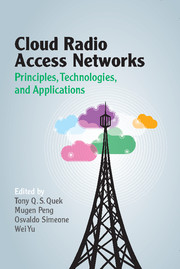Book contents
- Frontmatter
- Contents
- Acknowledgments
- Foreword
- Preface
- List of Contributors
- Part I Architecture of C-RANs
- Part II Physical-Layer Design in C-RANs
- Part III Resource Allocation and Networking in C-RANs
- 10 Resource Management of Heterogeneous C-RANs
- 11 Coordinated Scheduling in C-RANs
- 12 Delay-Aware Radio Resource Allocation Optimization in Heterogeneous C-RANs
- 13 C-RAN Using Wireless Fronthaul: Fast Admission Control and Large System Analysis
- 14 Toward Green Deployment and Operation for C-RANs
- 15 Optimal Repeated Spectrum Sharing by Delay-Sensitive Users
- Part IV Networking in C-RANs
- Index
- References
10 - Resource Management of Heterogeneous C-RANs
from Part III - Resource Allocation and Networking in C-RANs
Published online by Cambridge University Press: 23 February 2017
- Frontmatter
- Contents
- Acknowledgments
- Foreword
- Preface
- List of Contributors
- Part I Architecture of C-RANs
- Part II Physical-Layer Design in C-RANs
- Part III Resource Allocation and Networking in C-RANs
- 10 Resource Management of Heterogeneous C-RANs
- 11 Coordinated Scheduling in C-RANs
- 12 Delay-Aware Radio Resource Allocation Optimization in Heterogeneous C-RANs
- 13 C-RAN Using Wireless Fronthaul: Fast Admission Control and Large System Analysis
- 14 Toward Green Deployment and Operation for C-RANs
- 15 Optimal Repeated Spectrum Sharing by Delay-Sensitive Users
- Part IV Networking in C-RANs
- Index
- References
Summary
Introduction
Mobile cellular infrastructures, which have been deployed in recent decades, successfully provide seamless and reliable streaming (voice or video) services for billions of mobile users. From GSM/GPRS, UMTS, to LTE/LTE-A, transmission data rates have been enhanced a million-fold. The recent deployment of heterogeneous networks (Het-Nets) consisting of macro cells, small cells (femtocells, picocells), and/or further relay nodes ubiquitously support basic multimedia and Internet browsing applications. As a result, primitive human-to-human (H2H) communication applications using existing network architectures and technologies seem satisfactory. However, to substantially facilitate human daily activities in addition to basic voice or video and Internet access services, achieving full automation and everything-to-everything (X2X), had been regarded as an ultimate goal not only for the future information communication industry but also for financial transactions, economics, social communities, transportation, agriculture, and energy allocation. Full automation implies a significant enhancement of human beings' sensory and processing capabilities, which embraces unmanned or remotely controlled vehicles, robots, offices, factories, augmented or virtual reality, and sensory human interactions of cyber-physical-social systems. The goal is to employ distributed autonomous control to relieve or simplify network control and evolutive, by which resource utilization can be boosted in dynamic complex networks and be re-optimized after major environmental changes. However, X2X connection implies that diverse entities including human beings and machines are able to form general sense communities other than H2H, such as social networks that are human-to-machine (H2M) or machine-to-machine (M2M), facilitating the ultimate cyber-physical-social systems. Application scenarios include intelligent transportation systems (ITSs), volunteer information networks, the Internet of Things (IoT), smart grids, and much more.
To enable these various applications, boosting transmission data rates is just one of the diverse requirements. The performance in terms of end-to-end transmission latency, energy efficiency, reliability, scalability, cost efficiency as well as stability should also be fundamentally enhanced. As the data traffic from the Internet has gradually been dominating the traffic volume in mobile communication systems, in addition to an improvement in air-interface the migration to more efficient network architecture is definitely a must in technology development.
Information
- Type
- Chapter
- Information
- Cloud Radio Access NetworksPrinciples, Technologies, and Applications, pp. 227 - 254Publisher: Cambridge University PressPrint publication year: 2017
